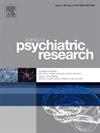强迫症患者脑电微态分析与机器学习分类。
IF 3.7
2区 医学
Q1 PSYCHIATRY
引用次数: 0
摘要
背景:脑电图(EEG)的微观状态表征是一种数据驱动的方法,用于在毫秒尺度上探索多个大脑网络的功能变化和相互关系。本研究旨在通过微观状态分析,探讨强迫症患者全脑功能网络的病理变化,进一步探讨其作为辅助诊断指标的潜在价值。方法:招募48例强迫症患者(中度以上焦虑症状33例,轻度焦虑症状15例)和52例健康对照(hc)。采用64通道脑电图采集闭眼期脑活动。比较强迫症患者与hc患者微状态特征的差异,探讨微状态特征与临床症状的关系。选择关键的微状态特征进行机器学习建模,实现目标分类。结果:强迫症患者从微观状态B过渡到微观状态C的概率显著低于正常强迫症患者,强迫思维因子得分与微观状态A持续时间、微观状态B的发生、从微观状态C过渡到微观状态B的概率显著相关,微观状态C的发生率与汉密尔顿焦虑评定量表(HAMA)得分显著负相关。机器学习模型在上述两组之间和中/轻度以上焦虑症状的OCD患者之间的测试集分类中AUC (Area Under The Receiver Operating Characteristic Curve)分别可以达到70.43%和77.13%。结论:强迫症患者脑电图微态特征发生改变,且与强迫思想和焦虑症状密切相关。此外,基于微状态特征的机器学习分类模型对强迫症的识别能力有限,未来还需要对该分类方法进行进一步优化。本文章由计算机程序翻译,如有差异,请以英文原文为准。
EEG microstate analysis and machine learning classification in patients with obsessive-compulsive disorder
Background
Microstate characterization of electroencephalogram (EEG) is a data-driven approach to explore the functional changes and interrelationships of multiple brain networks on a millisecond scale. This study aimed to explore the pathological changes of whole-brain functional networks in patients with obsessive-compulsive disorders (OCD) through microstate analysis and further to explore its potential value as an auxiliary diagnostic index.
Methods
Forty-eight OCD patients (33 with more than moderate anxiety symptoms, 15 with mild anxiety symptoms) and 52 healthy controls (HCs) were recruited. Brain activities during eyes-closed period were collected using 64-channel electroencephalography. The differences in microstate features between OCD patients and HCs were compared, and the relationship between the microstate features and clinical symptoms were explored. Key microstate features were selected for machine learning modeling to achieve targeted classifications.
Results
The probability of transition from microstate B to C was significantly lower in OCD patients compared to HCs, and the obsessive thoughts factor scores were significantly correlated with the duration of microstate A, the occurrence of microstate B, and the transition probability from microstate C to B. The occurrence rate of microstate C was significantly negatively correlated with the Hamilton rating scale for anxiety (HAMA) scores. The AUC (Area Under the Receiver Operating Characteristic Curve) of the machine learning model in the test set classification between the above two groups and between OCD patients with more than moderate/mild anxiety symptoms could achieve 70.43% and 77.13%, respectively.
Conclusion
EEG microstate characteristics were altered in OCD patients, and these changes were closely associated with obsessive thoughts and anxiety symptoms. Besides, the machine learning classification model based on microstate features has limited ability to identify OCD, and further optimization on this classification approach is still needed in the future.
求助全文
通过发布文献求助,成功后即可免费获取论文全文。
去求助
来源期刊

Journal of psychiatric research
医学-精神病学
CiteScore
7.30
自引率
2.10%
发文量
622
审稿时长
130 days
期刊介绍:
Founded in 1961 to report on the latest work in psychiatry and cognate disciplines, the Journal of Psychiatric Research is dedicated to innovative and timely studies of four important areas of research:
(1) clinical studies of all disciplines relating to psychiatric illness, as well as normal human behaviour, including biochemical, physiological, genetic, environmental, social, psychological and epidemiological factors;
(2) basic studies pertaining to psychiatry in such fields as neuropsychopharmacology, neuroendocrinology, electrophysiology, genetics, experimental psychology and epidemiology;
(3) the growing application of clinical laboratory techniques in psychiatry, including imagery and spectroscopy of the brain, molecular biology and computer sciences;
 求助内容:
求助内容: 应助结果提醒方式:
应助结果提醒方式:


